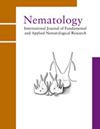Comparative phylogenetic analysis of vitellogenin in species of cyst and root-knot nematodes
IF 1.2
4区 生物学
Q2 ZOOLOGY
引用次数: 0
Abstract
Plant-parasitic nematodes (PPN) are an economically important group of crop pests and are oviparous animals; all nutrients required to develop and ensure the survival of their unhatched progeny need to be deposited within the egg, including proteins. The most abundant protein deposited is vitellin, formed of a precursor protein vitellogenin, which has roles in transporting lipids, providing amino acids and influencing post-embryonic development. The genes encoding vitellogenin have been well studied in Caenorhabditis elegans, but little is known about vitellogenin in PPN. Using the vitellogenin gene sequences from C. elegans, homologous sequences in the genomes of some economically important cyst and root-knot nematodes were identified and hypothetical vitellogenin genes were predicted. Protein domains were then determined. Sequences were aligned using MUSCLE and then used to construct phylogenetic trees using the maximum likelihood method. With the availability of genomic data and use of online local alignment tools, the vitellogenin encoding genes from C. elegans could be aligned to PPN genomes. All predicted genes contained the same protein domains as C. elegans; Vitellogenin_N, vitellogenin open beta-sheet and von Willebrand factor domain type D. The constructed phylogenetic tree clustered the species into four groups: root-knot nematodes, two cyst nematode groups and Caenorhabditis species. By determining the hypothetical vitellogenin genes in PPN and inferring their relationships, this could form a potential basis to understand further the role of vitellogenin in cyst and root-knot nematodes.卵黄蛋白原在囊线虫和根结线虫中的比较系统发育分析
植物寄生线虫(PPN)是一类重要的经济作物害虫,是卵生动物;发育和确保其未孵化后代存活所需的所有营养物质都需要沉积在卵子中,包括蛋白质。沉积的最丰富的蛋白质是卵黄蛋白,它由前体蛋白卵黄蛋白原形成,在转运脂质、提供氨基酸和影响胚胎后发育方面发挥作用。编码卵黄蛋白原的基因在秀丽隐杆线虫中已经得到了很好的研究,但在PPN中对卵黄蛋白原知之甚少。利用秀丽隐杆线虫的卵黄蛋白原基因序列,鉴定了一些具有重要经济意义的囊线虫和根结线虫基因组中的同源序列,并预测了假设的卵黄蛋白基因。然后测定蛋白质结构域。使用MUCLE对序列进行比对,然后使用最大似然法构建系统发育树。随着基因组数据的可用性和在线局部比对工具的使用,秀丽隐杆线虫的卵黄蛋白原编码基因可以与PPN基因组进行比对。所有预测的基因都包含与秀丽隐杆线虫相同的蛋白质结构域;卵黄蛋白原-N、卵黄蛋白原开放β片和von Willebrand因子结构域类型D。构建的系统发育树将该物种分为四组:根结线虫、两个囊线虫组和秀丽隐杆线虫。通过确定PPN中假设的卵黄蛋白原基因并推断它们之间的关系,这可以为进一步了解卵黄蛋白原在囊肿和根结线虫中的作用奠定潜在的基础。
本文章由计算机程序翻译,如有差异,请以英文原文为准。
求助全文
约1分钟内获得全文
求助全文
来源期刊

Nematology
生物-动物学
CiteScore
2.60
自引率
33.30%
发文量
67
审稿时长
3 months
期刊介绍:
Nematology is an international journal for the publication of all aspects of nematological research (with the exception of vertebrate parasitology), from molecular biology to field studies. Papers on nematode parasites of arthropods, and on soil free-living nematodes, and on interactions of these and other organisms, are particularly welcome. Research on fresh water and marine nematodes is also considered when the observations are of more general interest.
Nematology publishes full research papers, short communications, Forum articles (which permit an author to express a view on current or fundamental subjects), perspectives on nematology, and reviews of books and other media.
 求助内容:
求助内容: 应助结果提醒方式:
应助结果提醒方式:


